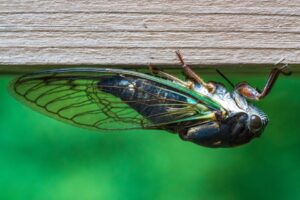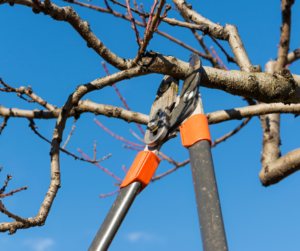As the warm weather approaches, so do the sounds that follow spring air. Early mornings are filled with songs from birds migrating back to their homes, looking for a friend, and looking for a meal. And every 13 or 17 years comes a different type of song that brings back a memory like a photograph. The large oak tree at the end of the street was infested from root to tip. This tree was fully engulfed by hundreds upon hundreds of Cicadas! The neighborhood dogs were going crazy trying to catch them as they zipped by us on our casual neighborhood stroll. But that’s not where it stopped… We were also left with a huge mess on our driveway, our porch, our roof, every crevasse of our yard, spreading across the entirety of our property.
It’s important to note that there are two types of cicadas: Annual and periodical cicadas.
The annual cicadas spend 2-5 years underground. Due to the synchronization of their emergence cycles, these cicadas appear yearly across the United States, emerging from July to September.

An Annual Cicada; Image Source: National Museum of Natural History
On the other hand, periodical cicadas burrow beneath the earth’s surface for either 13 or 17 years, and make their appearance as a “brood.” A brood of cicadas simply means that they emerge in a particular geographic area during a specific year. Each brood is composed of multiple species of cicadas that belong to the same emergence cohort. Their appearance, characterized by vast numbers, typically occurs between late April and June in the Eastern United States. 2024 marks a special year for periodical cicadas in that both the 13-year and 17-year broods will unearth and infiltrate in north-central Illinois!

A Periodical Cicada; Image Source: National Museum of Natural History
How can such harmless insects, known for their loud songs and distinctively bright appearance, commonly seen in Lake County, be such a pain and a harm to your property and landscapes? With their emergence comes the increased potential for damage to our environment and even your landscapes. So let’s explore the impact of cicadas on our natural surroundings and enlighten you about what property owners can do to prepare for and minimize the potential damage that result from their massive uprising.
Understanding Cicadas:
Before we delve into how to protect our landscapes, let’s take a moment to understand these intriguingly loud insects. Cicadas belong to the order Hemiptera and are known for their distinctive noises, produced by structures on their abdomens called tymbals. Despite their loud noise, cicadas are completely harmless to humans—they don’t bite, sting, or pose any direct physical danger to people or other animals. Most cicadas spend the majority of their lives underground as nymphs, feeding on tree sap and tunneling beneath the soil.
The Impact of Cicadas on Landscapes:
While cicadas may not pose a direct threat to humans, they can wreak havoc on our landscapes. During their emergence, cicadas lay eggs in the branches of trees, causing damage to young twigs and branches. Additionally, adult cicadas feed on the sap of trees, which can weaken them and make them more susceptible to diseases and other pests. For property owners, this can result in aesthetic damage to trees and shrubs, as well as potential long-term health issues for their landscape.
Preparing For The Cicada Emergence (Brooding):
As the anticipation of cicada emergence looms, it becomes imperative for property owners to take proactive measures to shield their landscapes from potential damage and further headache down the road. Here are some actionable steps you can take today so that you are as prepared as possible for what is to come!
Inspect Your Trees: Before the cicadas emerge, do a meticulous inspection of your trees. Look for any signs of damage or weakness, such as dead or damaged branches. Promptly prune these branches to mitigate the risk of cicadas laying eggs in them and causing further harm.

Consider Netting: For smaller trees deemed valuable or particularly vulnerable, the application of fine mesh netting can serve as a formidable barrier against cicada intrusion. By covering these trees with netting, property owners can effectively prevent cicadas from accessing the branches and inflicting damage.
Maintain Tree Health: A robust defense against cicada damage begins with maintaining the health and vitality of your trees. Ensure they receive adequate hydration through regular watering, especially during dry periods. Additionally, provide proper fertilization to nourish the trees, fortifying them against potential cicada onslaughts.
Plant Selection: Some plants are less attractive to cicadas than others. Choosing landscaping plants that cicadas are less likely to feed on or lay eggs in can help minimize damage to your property.
Burn Old Debris: Old branches that are left on the ground and scattered around your property or stacked for firewood can serve as a potential food source for cicadas. By safely burning old unnecessary branches and dead wood, you eliminate this potential food source, making your property less attractive to cicadas.
Ecologically Conscious Introductions: Cicadas have natural predators such as birds, squirrels, and bats. Attracting these seasonal predators to your property through bird feeders, bat boxes, have been shown to greatly help reduce not only cicada populations but other annoying bugs such as mosquitos, wasps, and flies just to name a few.
Consult a Professional: When in doubt, seek the expertise of a professional landscaping company like ILT Vignocchi, Inc. Consulting with experienced professionals can provide invaluable insights and tailored solutions to safeguard your landscape from cicada damage. From comprehensive assessments to personalized recommendations, we can guide property owners through effective cicada management strategies.
Implementing these proactive measures will significantly reduce the impact of cicada emergence on their landscapes. Seeking guidance from professionals when necessary will save you money and a headache in the long run. Remember, early preparation and strategic planning are key to preserving the health and beauty of your outdoor spaces amidst nature’s cyclical phenomena.
It’s important to note that cicadas are a natural part of the ecosystem, and their populations are cyclical. In many cases, the best approach is to allow natural processes to occur and focus on protecting valuable or vulnerable plants and allow the professionals at ILT Vignocchi Inc. to take care of all of your landscaping needs. Rest assured that we will be implementing tried-and-true methods to take a proactive approach to the great awakening ahead.
Call us at 847.487.5200 (ext: 2220) for a consultation, or send a message our way to get started!

